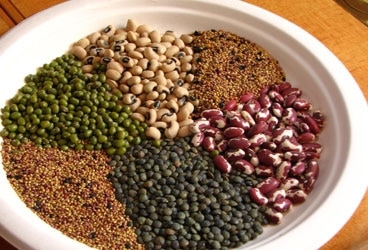
beans 368
“I miss my garden!” I whined to my husband, Richard, as I crouched over the pitiful result of yet another attempt to produce something green, healthy, and edible from a flowerpot set on the deck of our 28-foot Bristol Channel Cutter, Mandy (www.sailblogs.com/member/mandy).
My epiphany came in our local chandlery. A modest display in the galley section showed various bags filled with alfalfa and sunflower seeds and mung beans; a plastic, multilayered sprouter that resembled a hamster’s penthouse; and a slim volume on the art of sprouting.
I discovered that the empty Mason jars I’d hoarded in our bilges for preserving those unmanageable deep-sea catches could have a second life as incubators for baby sprouts by covering the mouth not with the lid but with cheesecloth and using a rubber band to hold each firmly in place. There are also lids made specifically for open-mouth jars that can be found online or in health-food stores.
Sprouting is simple and bountiful, and it’s perfect for cruisers. Bulk dry beans and seeds are compact for long-term storage. To begin the sprouting process, place two tablespoons of seeds of your choice in a clean quart jar. Cover with fresh, preferably filtered, water and soak overnight. Drain and shake the seeds well and place the jar on its side in an airy but darkened corner of the galley. By the next day, the wonder of germination will have produced tiny, white sprout tips on the seeds. Beans take one more day to show visible signs of life; grains take longer, but they catch up fast.
After the initial soak, all that’s required is to rinse the burgeoning contents once or twice each day in a small amount of clean water and shake vigorously until drained. If you’re cruising, save this precious rinse water and add it to sauces or soups. In four or five days, the jar will be bursting with an incredible tangle of juicy, highly nutritious sprouts.
I like to stagger my germinations with a day or two in between so we on Mandy have a constant supply coming up. To green the leafy ends, simply set in a bright area of the galley, but not in direct sun. Store the sprouts refrigerated for several days, or just gobble them right away at the peak of their nutritional value. Use them in sandwiches, salads, omelets, stews, muffins, bread, and soup (such as the one below, which is perfect for overnight passages. The soup holds its heat well in a thermos, has tons of protein, and the carrots help you see in the dark!)
Helpful books on sprouting include Sprout Garden by Mark M. Braunstein and The Sprouting Book: How to Grow and Use Sprouts to Maximize Your Health and Vitality by Ann Wigmore. Online sprout suppliers include Jaffe Bros. (www.organicfruitsandnuts.com) and Mumm’s Sprouting Seeds (www.sprouting.com).
Sprouted Green Lentil and Split Pea Soup
1 cup dried split peas
3 cups water
1 potato, diced
1 onion, diced
3 carrots, diced
3 cloves garlic, crushed
2 tablespoons olive oil
1/2 teaspoon dried thyme or oregano
1 bay leaf
1 cup green lentils, sprouted
1 tablespoon tamari (for vegetarians) or
2 ounces ham hock or bacon, chopped
Dash cayenne pepper
Salt, to taste
Cook split peas for 30 minutes in water in a covered pan. Add potatoes, onion, carrots, garlic, oil, and herbs and continue cooking until soft. Remove bay leaf. Mash with a potato masher. Add sprouted lentils and tamari or ham/bacon and heat gently to simmer for 20 minutes, stirring. Serve with a dash of cayenne pepper on top and warm, crusty bread. Serves two.







